|
Sleep
/ Wakefulness
- Consciousness - Memory - Left
/ right
hemispheres.
1.
Sleep - Wakefulness:
Sleep
- wakefulness are expressions for
living individuals' double roles:
During sleep an
individual has the role as a relative
whole in itself. Awake it has a
role as a part of the entire whole.
Awake, as
part of the whole, she represents
center - the 0-pole (half of Universe)
- in relation to the surrounding
world as anticenter - the 00-pole
(the other half) - and is consequently
fundamentally outward directed.
While sleep is characterized by
internal double-direction outwards
<====> inwards.
With this aspect it becomes natural
that sleep also includes internal
activity. The outward directed
component during sleep is evident
from the fact the sleep is actively
governed from deep centers in the
brain stem, mainly from pons (Mf).
Simultaneously,
sleep is the result of active inhibition
from higher levels, hence characterized
by inward direction. The epiphysis
dorsally (~ 00-pole) produces sleep
hormones as melatonin and different
types of sleep phases can be triggered
from areas on higher levels in diencephalon
and cerebral cortex (Nf).
From the CSF fluid,
which surrounds the brain in ventricles
and around cortex, substances that
trigger sleep are secreted inwards
the brain, for instance γ-hydroxibuturate
(Nf p. 337).
These
cavities for CSF fluid are originally
the primary surrounding of an embryo
= anticenter, which get built-in
through the invagination of the
neural tube. The internal secretion
too becomes an expression for the
component of inward direction in
sleep. The role of an individual
as a relative whole entity in itself
and two-way directed leads to internal
polarizations - (as a 5-dimensional
unit in the dimension model here
implies polarizations to a dimension
chain).
The
main polarization appears as the
one between orthodox (non-REM, NREM)
sleep and paradoxical REM sleep,
(REM for rapid eye movements), during
which most dreaming occurs.
Number of periodic
changes between the two kinds of
sleep is said to be about 4 - 6,
which could have connection with
number of steps in a dimension chain.
 Fig
BM-1-133-1 This connection
seems supported by later research
according to Wikipedia, "Sleep"
and a figure (319px-Sleep_Hypnogram_svg-Wikipedia.jpg)
from this source:
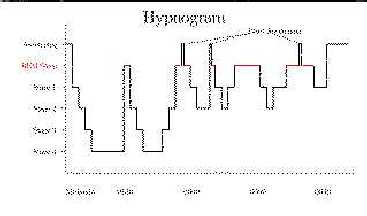 Fig
BM-2-319px Fig
BM-2-319px
Note the
stepwise decreasing depth of NREM
sleep towards more superficial levels
as towards lower dimension degrees
(d-degrees), besides the steps between
REM and NREM sleep. Adult
humans sleep about 1/3
of the 24 hours: cf. the sleeping
individual as a whole (d-degree
5 ~ 0/00)
in itself !
(However,
elephants sleep only ~ 3 hours.) 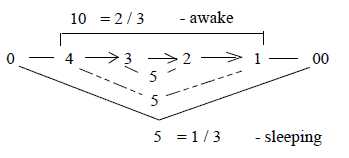 Fig
BM-3-134-2 Fig
BM-3-134-2
According
to older data (Mf 1979) about
4/5 of
sleep time is of the orthodox NREM
type, 1/5
of the REM-type in average.* For
newborn babies the quotient can
be 50/50.
*(Hardly
agreeing with the figure from Wikipedia
above?) Several features make
it possible to interpret the two
types of sleep as expressions for
inward versus outward direction
as shown with the arrows in the
figure below;
 Fig
BM-4-134-3 - Stimulation
in thalamus gives orthodox sleep,
stimulation of a center in pons,
a deeper level, triggers paradoxical
sleep (Nf p. 333). One could
imagine that it should be the opposite,
deeper center in the brain giving
a deeper sleep, but with arrows
for directions it seems to make
sense. Cf. the reticular
system ARAS in the brainstem.

Fig
BM-5-134-4 - Orthodox
sleep is characterized by a domination
of activity in the parasympathetic
nervous system: a decrease of blood
pressure, increasing activity in
intestines etc., thus by the inward
direction of the autonomous nervous
system (ANS). While paradoxical
sleep is characterized by increasing
activity in the sympathetic nervous
system, the outward direction of
ANS, increasing blood pressure and
pulse frequency etc. (LEL).
- The activity in visual
cortex increases during REM sleep
with its rapid eye movements, as
expression for the direction outwards,
upwards the dorsal lobe of cortex,
with answers as the visual pictures
of dreams. - It may appear
a bit curious that muscle tonus
are blocked or effectively lowered
during paradoxical sleep, in spite
of general muscle activation being
a function of the sympathetic nervous
system.
Yet,
real muscle activity concerns outer
environment, and also sensory impressions
from outside are suppressed.* It
obviously underlines that the polarization
between ortho- and para-sleep concerns
the autonomous system, the inner
milieu, the individual as "autonomous"
in the sense of a whole in itself.
(A "nuclear power plant"
during reparation.)
-
That persons are more difficult
to awake during paradoxical REM
sleep than during orthodox NREM
sleep may seem just 'paradoxical'
but shows on the simultaneous suppression
of sensory signals from outer world
during sleep.
During
REM phases a person can be said
to exist under and inside the curve
in the figure above as under a barrier,
during orthodox sleep outside it
and without obstacles to the surface
of wakefulness. (Besides that
the person is already fully occupied
in its inner dreams. Dreams as mental
reparations?)
What
would the curve as a barrier, defined
by the opposite directions, then
represent? Perhaps something like
the potential barrier around an
atomic nucleus? - That different
hormones give (or are involved in?)
the two types of sleep is a further
indication on their polarity. -
Old individuals can lose the paradoxical
REM sleep (LEL). A possible
explanation is that aging often
implies that the force from inside
(arrows upwards in the figure) grows
weaker. The identity becomes more
dependent on what is given from
outside, the created, surrounding
milieu as of memories in backward
direction of time. It agrees with
the findings that small children
sleep more REM-sleep than adults. EEG
waves:
Scientists differentiate
simplified between 5 general types
of EEG waves from conscious integrating
patterns to deeper NREM sleep: Gamma
waves, ~ 30 - 100 Hz —
conscious, integrating patterns,
Beta waves, ~ 12 - 30 Hz —
normal, concentrated wakefulness,
Alpha waves, ~ 8 - 12 Hz —
relaxed wakefulness with closed
eyes,
Theta waves, 4 - 7 Hz
—
drowsiness, transient stages I and
II in sleep, more in children
Slow wave sleep, Delta waves, (1)
— 4 Hz. (Numbers from
http://en.wikipedia.org/wiki/Electroencephalography#Wave_patterns) Delta
waves have generally the highest
amplitudes. The steps correspond
very roughly as it seems to a transition
from higher amplitudes to higher
frequencies. An increase of the
amplitude is seen as a decrease
in frequency (Mf).
The
pattern is thus in compliance with
the general system for nerve signals:
the opposition between amplitude
modulation in inward direction to
the cells, frequency modulation
in outward direction. Inwards towards
deeper NREM sleep (as arrows in
the figure above) and outwards as
towards wakefulness.
2. Wakefulness - Consciousness:
The
(A)RAS system in the brain stem
(in upper part of the reticular
system) activates all parts of cerebral
cortex, and the unspecific projections
from thalamus leads to general wakefulness.
Hence, wakefulness can be described
as radial divergence from deep inner
centers.
It
may be remembered in this context
what has been mentioned about "will",
psychologically often apprehended
as a governing force from "above",
from higher centers. Will-governed
motions however cannot be triggered
by electric stimulation in cortex.
Activity in deeper centers is involved.
However, wakefulness is
not the same as consciousness. A
person can be awake even without
a cerebral cortex (Nf)! Consciousness
demands in the first place undamaged
deeper centers but also these in
interaction with a cortex. "Probably"
participation of both ARAS and thalamus
as well as of cerebral cortex (Mf). If
the basis for what usually has been
meant with "consciousness"
is the meeting or interaction of
the opposite poles 0 and 00 (as
ARAS and anticentric cortex) and
directions outwards → ← inwards, consciousness
could perhaps be described as a
"rebound in cortex", of
"reflection", as light
bounces from a mirror.
Compare
in the development of an embryo
when the top of invaginated archenteron
from vegetative pole reaches the
animal pole and this induces the
invagination of a neural tube. Elementary
emotions as pain and its
opposite: anguish (as a fear for
a threatening pain, cf. anguish
to fall) have naturally influence
on consciousness.
Physiologically
pain turns off alpha waves, gives
beta waves corresponding to attention,
characterized by outward direction..
Anguish
seems to block neural connections
and integration and mentally imply
repression, and inhibition, hence
constrict consciousness. (Anguish
seems to give a big disorder in
normal EEG-patterns, no closer information
available in here used sources.)
If pain
can be described as a lack
of adequate answer from outside,
anguish becomes the expression for
an unanswered inward direction as
the lack of supporting ground in
the fear to fall. (Referring here
to a book in Swedish: "The
I versus the Ego. Psycho-geometry", presented in English here.)
Both these
emotions concerns self-preservation,
the individual as a whole in itself,
but pain its outward direction,
anguish its inward direction in
terms of the dimension model.
Cortex sends impulses
downwards to the reticular formation
in the brain stem and can thus exert
an influence on its own activity.
(It has probably an impact on which
psychological sense a certain stimulation
has (LEL p. 199). Cf. blocking
of incoming signals in stages of
potential anguish. For a
person in the role of part in the
entirety, only a 0-pole, a state
of wakefulness, the real anticenter
isn't the cortex as during sleep
but the surrounding world. Consciousness
can be assumed to grow through responses
from this outer world - as answers
on the person's own activity from
"0-pole" - and thus be
a question of a gradual development.
The word con-sciousness
(from Latin) means with - know(ledge).
The answer from outside gives the
word with = con.
Consciousness
in the psychological sense surely
grows through increasing interaction
and connections between neurons
in the brain, but the brain develops
through double-direction and presupposes
an active, localized center.
It's shown that
the activity in the brain during
drowsiness on the way to sleep doesn't
disappear but gets disintegrated,
more randomly spread, while wakefulness
or physiological "consciousness"
gives integrated patterns. This
in agreement with the dimension
model where the force form 0-pole
is defined as the integrating one,
the force from 00-pole as the disintegrating
one.
Besides the physiological
and psychological purport of the
word consciousness, it cannot be
excluded that there is a knowledge
without the prefix with = con, as
an "inner eye", capable
of getting all the inner knowledge
from depths of the own body structures,
atoms and history. Even during "wakefulness"
without a cortex, although without
its transformations into identifying
symbols and signs. "Awareness"
is another sense of "consciousness"
and could be described as a special
part of knowledge, integrated in
the total activity of a conscious
brain.
3. Memory:
Centers
for creation of long-term memories
are situated in areas around the
3rd ventricle, hippocampus and amygdaloid
body that are parts of the limbic
system. It's areas that also are
connected with centers for elementary
emotions.
Memories
belong to passed times, the time
direction inwards, as the limbic
system is inwards from cortex. Storage
of these long-term memories occurs
however in cortex. Human
experiences indicate that a free
access to one's memories demand
a position "inside" the
memories, a not blocked center.
It's surely a rather
common experience that one fails
a forgotten name or other such special
details when trying to reach the
memory as from outside - inwards,
from a detailed verbal and sensory
level, while the memory pops up
later during a relaxed, less concentrated
level; psychologically from
an underlying level that awakes
a bigger association area. It implies
that the memories exist in outward
direction from the I in the same
sense that storeroom shelves surround
a storeroom manager. Compare repression
of bad memories.
Hence,
these mechanisms seem to indicate
that involvement of deeper centers
in the brain is necessary for memory
as well as for consciousness. Principally,
it may be presumed as a fundamental
principle that wider areas
of cortex, including association
areas, are integrated from deeper
levels in the brain than from more
superficial ones, illustrated by
the gradient funnel below:
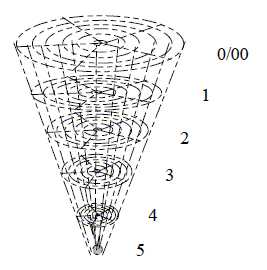 Fig
BM-6-114-3 Fig
BM-6-114-3
4. Right - Left hemispheres of
the brain:
3rd coordinate
axes of the body, the right-left
one, may probably be regarded as
bilateral symmetric at first stages
of the embryonic development, but
several asymmetric features develop
later along this axis too: in the
transverse aortic arch and which
side, the right (in birds) and the
left in humans (Kz) that
become the big aorta. Further the
asymmetric positions of heart, liver
and spleen for instance.
The
differentiations between the cerebral
hemispheres become an expression
of this polarization - with character
of complementarity, both in size
and in functions.
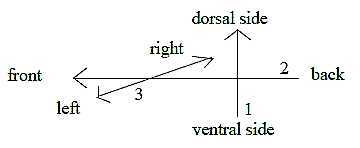 Fig
BM-7-137-1 Fig
BM-7-137-1
- Spatial apprehension,
understanding of 3-dimensional relations
- and of emotional content in conversations
- are among the functions that have
been attributed to the right hemisphere.
- Reading, writing, speech and "mathematical
calculation" are functions
(and centers) most often localized
to the left hemisphere.
A
more appropriate and general description
has been said to be that right hemisphere
(usually) is responsible for comprehensive
apprehension, the left hemisphere
for analytic functions.
Translated to a dimension chain:
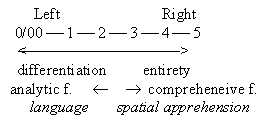 Fig
BM-8-137-2 Fig
BM-8-137-2
We may note
that reading, writing and speech
(and some types of mathematics and
so called "logic") demand
an ability to linear, 1-dimensional
functions, which demands ability
for transitions from higher d-degrees,
as from 3- to 2-dimensional pictures
for instance.
The
fundamental double-direction is
revealed in many common transpositions
of letters.
It
has been said that right hemisphere
only can count to 20, that's 5 x
4, first steps in a dimension chain.
Impact of left and right
halves of the brain on the function
of the other half?
According
to the dimension model the differentiation
should also be a question of directions
as marked in the figure above. Witch
influence could the centers in right
hemisphere and a force as direction
"outwards" from these
towards the left hemisphere have
on the development of speech and
other "linear" abilities.
(Analysis as equivalent with dissolution
of factors.) And vice versa; a force
from left centers "inwards"
on the right hemisphere? (A synthesizing
factor.) Can they be regarded as
two gradients in each other:
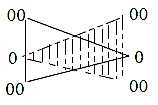 Fig
BM-9-117-3 Fig
BM-9-117-3
It's left
as an open question here if such
an interpretation agrees with other
findings, for instance from persons
with only one hemisphere or where
a person has got the connection
between the hemispheres cut off.
Such a connection for the mutual
interplay between directions must
in those cases have existed earlier
in development of the brain or occur
through deeper, underlying levels
in diencephalon or brain stem. The
interpretation of right hemisphere
as "the inner pole", the
left one as "the outer"
pole in a relation of the type 0
—
00 does agree with a theory that
left hemisphere hampers emotions
that arouse from right hemisphere.
In the same way as elementary emotions
have centers on inner levels as
in the limbic system, and cortex
to a big extent represent inhibiting
impulses, it sounds natural that
emotions should originate in direction
from the "inner" right
hemisphere and psychological, inhibiting
impulses from the "outer"
left hemisphere in its secondary
role as anticenter. Left-handed
people make up about 9 % of all
in our days and are said to have
grown in number. It could assumably
depend on less authoritarian societies,
less suppression, more liberation
of emotions - in opposition to the
old, in language established opinion
that right hand is "recht"
(German), "right" as opposite
to wrong (in western cultures at
least).
Cf.
too in the world of etiquette the
position of a man at left side of
a woman and the old conception (or
demand) that man is the representative
of reason and logic, the woman of
feelings.
|

 Fig
BM-2-319px
Fig
BM-2-319px Fig
BM-3-134-2
Fig
BM-3-134-2

 Fig
BM-6-114-3
Fig
BM-6-114-3  Fig
BM-7-137-1
Fig
BM-7-137-1 Fig
BM-8-137-2
Fig
BM-8-137-2 Fig
BM-9-117-3
Fig
BM-9-117-3